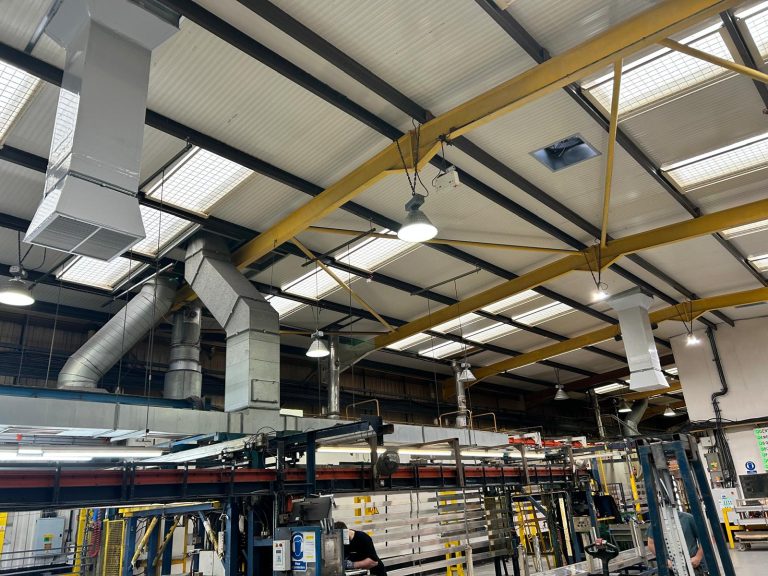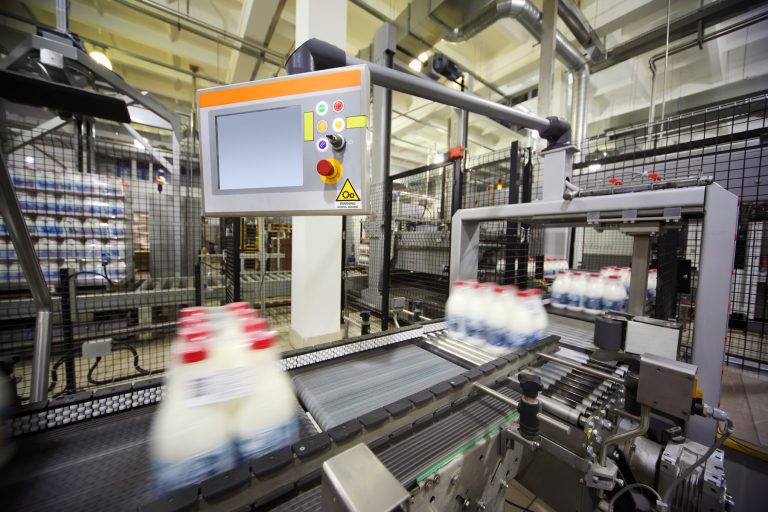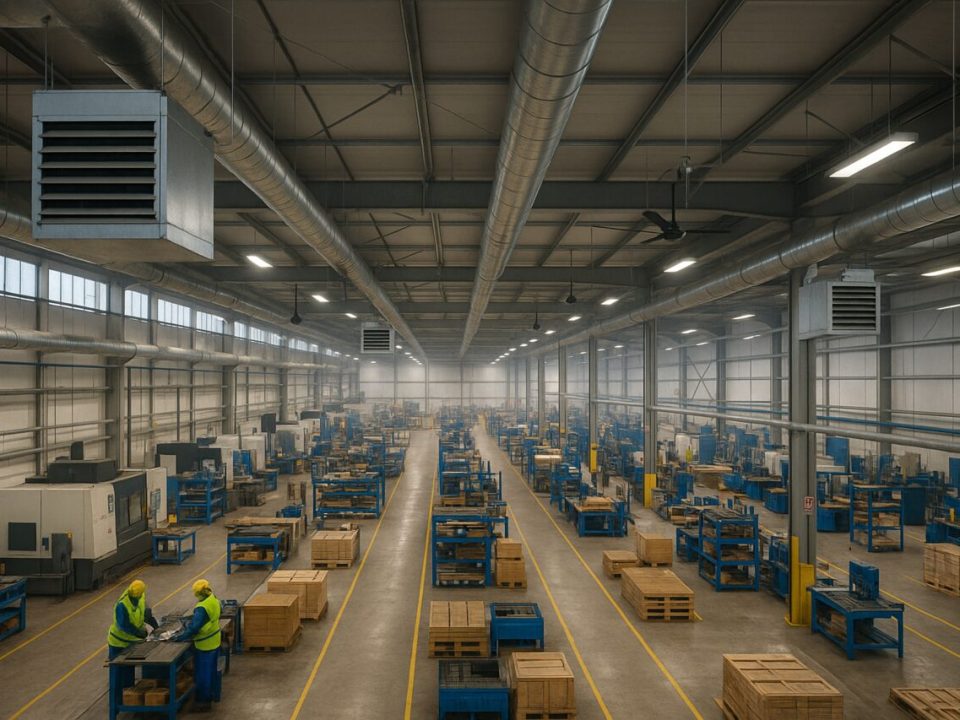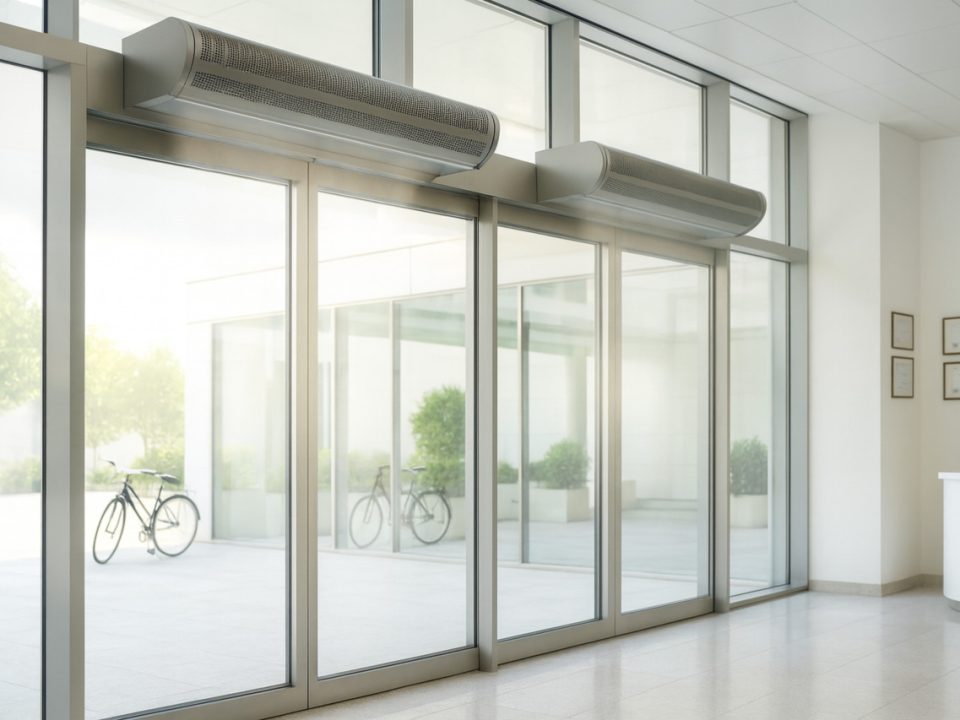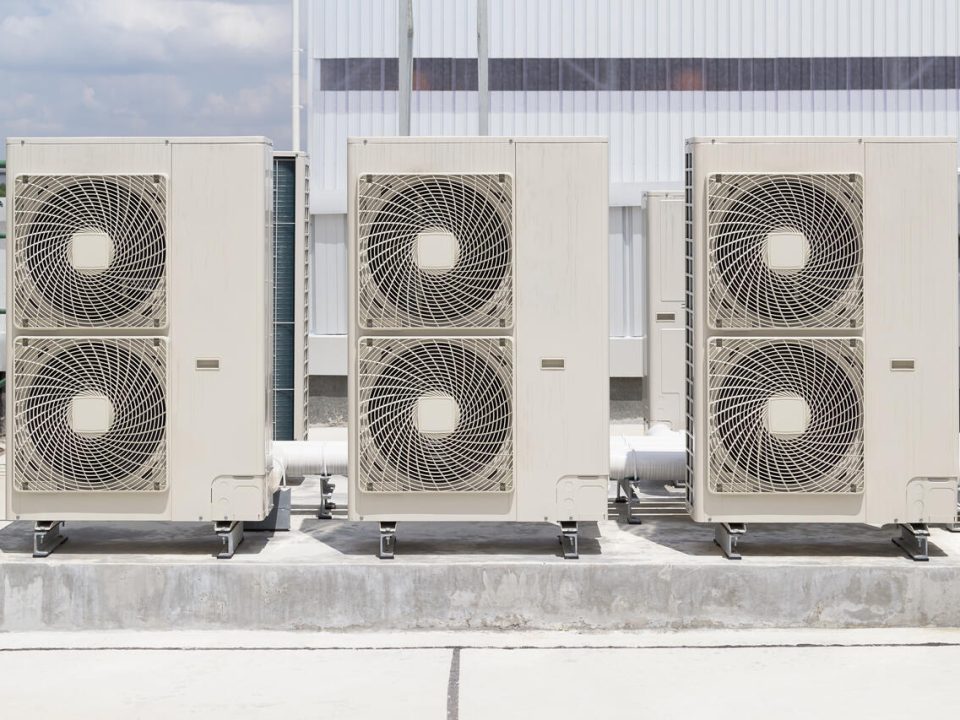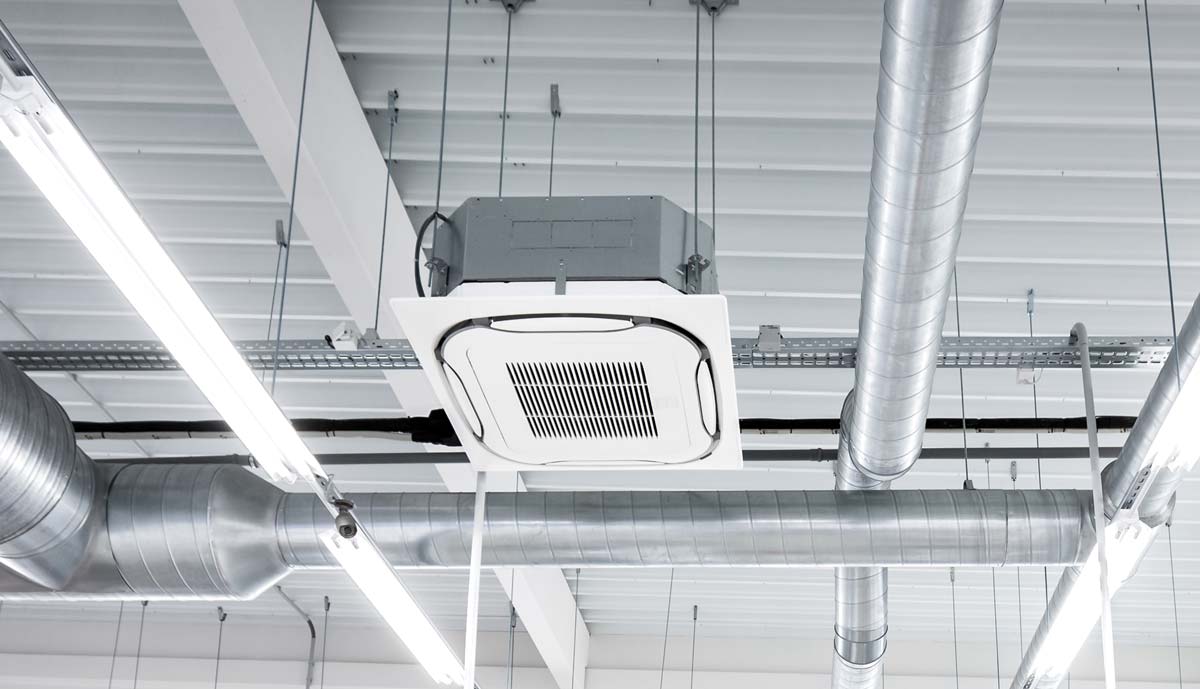
Commercial Air Conditioning Installation: Expert Solutions for Your Business
June 2, 2025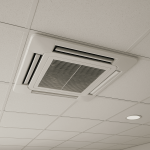
Ducted Air Conditioning UK: What It Is, How It Works, and the Best Alternatives
June 12, 2025Table of Contents
What Is a Commercial Ventilation System? A Complete Guide for UK Businesses
A commercial ventilation system is far more than just moving air around your building. It’s a sophisticated network of equipment designed to maintain the air quality that keeps your employees healthy, your customers comfortable, and your business compliant with UK regulations. Unlike the simple extractor fan in your home bathroom, commercial systems must handle complex air quality challenges across large spaces whilst managing energy costs that can make or break your bottom line.
The fundamental difference between commercial and domestic ventilation lies in scale and sophistication. Where a house might need 150 cubic metres of air per hour, a typical office requires 10-15 cubic metres per hour per person, multiplied by potentially hundreds of occupants. Add in the heat generated by computers, lighting, and human activity, plus the pollutants from cleaning products, office equipment, and outdoor air, and you begin to understand why commercial ventilation is a specialised field.
Why Your Business Actually Needs Professional Ventilation
The Workplace (Health, Safety and Welfare) Regulations 1992 don’t just suggest adequate ventilation – they demand it. But beyond legal compliance, poor ventilation costs British businesses millions annually through reduced productivity, increased sick leave, and higher energy bills. Research by the Building Research Establishment found that improving indoor air quality can increase employee productivity by up to 11%. In a business employing 50 people on £25,000 salaries, this productivity gain is worth £137,500 annually – far more than the cost of a quality ventilation system.
Poor ventilation creates a cascade of problems. Carbon dioxide levels above 1,000 parts per million cause drowsiness and reduced concentration. Humidity above 60% encourages mould growth and dust mites. Volatile organic compounds from carpets, furniture, and office equipment can trigger headaches and respiratory problems. A properly designed commercial ventilation system addresses all these issues systematically.
Modern commercial buildings are increasingly airtight for energy efficiency, making mechanical ventilation essential. Natural ventilation through opening windows is unreliable in the UK climate and impossible to control. You can’t adjust outdoor air quality, temperature, or humidity by opening a window, but a well-designed mechanical system gives you precise control over your indoor environment.

Understanding Different Types of Commercial Ventilation
Natural vs Mechanical Ventilation Systems
Natural ventilation relies on wind pressure and temperature differences to move air through buildings. Whilst this approach works for some applications, it offers no control over air quality, temperature, or humidity. Modern commercial premises require the consistency and precision that only mechanical systems can provide.
Mechanical ventilation uses fans, ductwork, and controls to manage airflow precisely. These systems maintain consistent performance regardless of weather conditions, building occupancy, or external air quality. The investment in mechanical systems pays dividends through improved comfort, better air quality, and regulatory compliance.
Supply and Extract Ventilation Configurations
Supply-only systems push fresh air into buildings, creating positive pressure that forces stale air out through gaps and openings. This approach works well in clean environments where you want to prevent outdoor pollutants entering, such as electronics manufacturing or pharmaceutical facilities. However, relying on uncontrolled air leakage for exhaust limits precision and can waste energy.
Extract-only systems pull stale air out whilst allowing fresh air to enter naturally. This creates negative pressure, useful in areas producing odours or contaminants that you want to contain. Commercial kitchens, workshops, and toilets typically use extract systems. The downside is limited control over fresh air supply quality and quantity.
Balanced ventilation systems provide both controlled supply and extract, offering complete control over air quality and building pressurisation. Most modern commercial installations use balanced systems because they deliver consistent performance and maximum flexibility.
Heat Recovery Ventilation – The Game Changer
Heat recovery ventilation represents the biggest advancement in commercial ventilation technology. Traditional systems waste enormous amounts of energy by expelling heated indoor air. In the UK climate, this waste represents 30-50% of a building’s total heating costs. Heat recovery systems capture this waste and dramatically improve efficiency.
The most common type uses cross-flow heat exchangers where warm exhaust air and cool supply air flow perpendicular to each other through alternating layers of plates. Heat transfers through the plates whilst the air streams never mix. Counterflow designs achieve higher efficiency by having air streams flow in opposite directions through adjacent channels.
Modern heat recovery systems achieve 85-90% efficiency, reducing heating costs by £15-20 per square metre annually in typical UK offices. The additional cost over basic ventilation is usually recovered within 2-4 years through energy savings.
Our Live Projects: A Snapshot
At Inergy Group, we are currently working on several live projects in various industries:
-
Textile Manufacturer in Huddersfield: Custom-designed ventilation to improve air quality in a textile manufacturing facility.
-
Bus Service Depot in Preston: HVAC system installation for a depot where buses are serviced, ensuring a safe and healthy working environment.
-
Frozen Pizza Manufacturer in Bolton: Tailored ventilation to manage heat and improve air quality in a frozen pizza manufacturing plant.
-
Sign Manufacturer: Ventilation systems to improve air quality in a sign manufacturing facility.
-
Pneumatic Company – Industrial Machine Manufacturer: Ventilation solutions to manage heat and airborne pollutants in an industrial machine manufacturing setting.
-
Service Graphics – Large-Scale Printing Firm: HVAC system installation for a large-scale printing company to enhance air circulation and remove contaminants.
-
Large Garage with MOT Bays: Installation of a ventilation system for a garage with MOT bays to ensure air quality and comfort.
-
Building Supplies Manufacturer in Wigan: Ventilation solutions for a building supplies manufacturer to meet safety and air quality requirements.
-
Plastics Company in Chesterfield (Food and Beverage Packaging Supplier): Custom HVAC systems for a plastics company manufacturing food packaging, including coffee cup lids.
Each project is tailored to the specific needs of the business, ensuring compliance and improving air quality in diverse industrial environments.
Commercial Kitchen Ventilation Requirements
Grease Extraction and Fire Safety
Commercial kitchen ventilation faces unique challenges that standard office systems cannot handle. Cooking generates enormous amounts of heat, grease-laden vapours, and strong odours that must be captured at source and expelled effectively. A busy restaurant kitchen might generate 50-100 kilowatts of heat – equivalent to running 50-100 electric fires simultaneously.
Grease extraction systems use canopy hoods positioned directly above cooking equipment to capture contaminated air before it can spread. These hoods create a curtain of air that contains and removes grease vapours. The extracted air passes through multi-stage baffle or mesh filters that trap grease particles before they can deposit in ductwork.
Fire suppression integration is crucial for kitchen safety. Modern systems interlock with automatic fire suppression equipment – if the fire system activates, ventilation fans shut down immediately to prevent spreading flames whilst fire-suppressing agents flood the ductwork and equipment.

Kitchen Ventilation Costs and Specifications
Commercial kitchen ventilation system prices vary enormously with complexity and scale. A simple takeaway operation might need a £3,000-£5,000 system, whilst a large restaurant could require £20,000-£50,000 for comprehensive extraction, makeup air, and fire suppression integration.
| Kitchen Type | Typical System Cost | Air Changes/Hour | Special Requirements |
|---|---|---|---|
| Small takeaway | £3,000 – £5,000 | 15-20 | Basic grease extraction |
| Café/bistro | £5,000 – £12,000 | 20-25 | Grease extraction + makeup air |
| Full restaurant | £12,000 – £30,000 | 25-30 | Integrated fire suppression |
| Large commercial kitchen | £30,000 – £50,000+ | 30-40 | Full automation + monitoring |
Running costs are significant too – a typical restaurant extraction system uses 5-15 kilowatts continuously, costing £5,000-£15,000 annually in electricity alone. However, these costs are unavoidable for regulatory compliance and kitchen safety.
Mechanical Ventilation with Heat Recovery (MVHR)
The Technology Behind MVHR Systems
MVHR systems represent the pinnacle of commercial ventilation technology, combining precise air quality control with exceptional energy efficiency. These systems use sophisticated heat exchangers to capture waste heat from extracted air and transfer it to incoming fresh air without cross-contamination.
The heart of an MVHR system is the heat recovery unit, typically featuring either plate or rotary heat exchangers. Plate heat exchangers use alternating layers of thin metal or plastic sheets where warm exhaust air and cool supply air flow through adjacent channels. Heat conducts through the separator material whilst the air streams remain completely separate.
Rotary heat exchangers achieve higher efficiency using a slowly rotating wheel coated with heat-absorbing material. The wheel alternately contacts exhaust and supply air streams, transferring both sensible heat and moisture. Whilst more efficient, rotary systems require more maintenance and aren’t suitable for applications requiring complete air separation.
Energy Efficiency and Cost Benefits
Modern MVHR systems achieve remarkable efficiency levels, typically recovering 85-92% of waste heat. In a 1,000 square metre office building with a £10,000 annual heating bill, an efficient MVHR system could save £6,000-£8,000 annually. The additional cost over basic ventilation is usually £10,000-£20,000, providing payback periods of 2-3 years.
Beyond direct energy savings, MVHR systems provide superior comfort through consistent temperatures and humidity levels. They also reduce heating and cooling equipment requirements, lowering capital costs for boilers, chillers, and air conditioning systems.
Applications Across Different Industries
MVHR technology suits various commercial applications, from offices and schools to manufacturing facilities and workshops and warehouses. Each application requires specific design considerations for optimal performance.
In food and beverage manufacturing, MVHR systems must handle higher moisture loads and potential contamination risks. Plastic moulding manufacturing requires systems capable of managing process heat and chemical vapours whilst maintaining energy efficiency.
Local Extraction Ventilation (LEV) Systems
Capturing Contaminants at Source
Local extraction ventilation takes a targeted approach to air quality management by capturing contaminants at their source before they can spread throughout the workplace. LEV systems are essential in industrial environments where processes generate dust, fumes, vapours, or other harmful substances.
Effective LEV design requires understanding the contaminant generation process, airflow patterns, and capture requirements. The system must create sufficient airflow velocity to capture contaminants whilst minimising energy consumption and avoiding disruption to work processes.
A recent case study involving a building product manufacturer demonstrates LEV effectiveness. The facility’s production process generated significant air particulates and heat, creating poor working conditions. By implementing dual integrated systems combining LEV with conventional mechanical ventilation, air quality improved dramatically whilst maintaining production efficiency.
LEV Design Principles and Applications
Successful LEV systems follow three fundamental principles: capture, contain, and clean. The capture element must generate sufficient airflow to collect contaminants at source. Containment ensures contaminants are directed away from workers and into the extraction system. Cleaning removes or neutralises contaminants before air discharge.
Different industrial processes require specific LEV approaches. Welding operations need flexible extraction arms that can position close to the work. Grinding processes require downdraft tables that pull particles away from operators. Chemical processes might need enclosed booths with complete containment.
In the textiles manufacturing sector, LEV systems must handle fibrous particles that can clog conventional filters. Specialised filtration and stainless steel ductwork resist corrosion from manufacturing processes whilst providing long-term reliability.
Get in touch with us today:
📞 Phone: 01204 929999
✉️ Email: info@inergygroup.co.uk
System Sizing and Design Considerations
Calculating Ventilation Requirements
Proper sizing forms the foundation of effective commercial ventilation. Undersized systems cannot maintain air quality standards whilst oversized systems waste energy and money. The calculation process starts with building occupancy, usage patterns, and regulatory requirements.
Office spaces typically require 10-12 litres per second per person of fresh air, whilst meeting rooms need 20 litres per second per person due to higher occupancy density. Retail spaces require 8 litres per second per person, but must also consider customer flow and product storage requirements.
Industrial applications have more complex requirements. Heat-generating processes may need 20-50 air changes per hour to maintain comfortable temperatures. Dust-generating operations might require specific capture velocities at source points. Chemical processes need ventilation rates based on toxicity levels and exposure limits.

Ductwork Design and Air Distribution
Ductwork design significantly affects system performance and energy consumption. Undersized ducts create excessive pressure losses, forcing fans to work harder whilst generating noise. Oversized ducts cost more initially but reduce operating costs and improve acoustics.
The optimal approach balances capital and operating costs through careful velocity selection. Main distribution ducts typically operate at 8-12 metres per second, reducing to 4-6 metres per second in branches serving occupied areas. Lower velocities reduce noise and pressure losses but require larger, more expensive ductwork.
Air distribution strategy depends on space function and geometry. Mixing ventilation systems supply air at ceiling level and rely on good mixing throughout the occupied zone. Displacement systems supply air at low level and low velocity, using natural buoyancy to remove heat and contaminants at high level.
Control Systems and Smart Technology
Demand-Controlled Ventilation
Modern commercial ventilation systems incorporate sophisticated controls that optimise performance automatically. Demand-controlled ventilation uses sensors to adjust airflow based on actual requirements rather than design assumptions, providing significant energy savings whilst maintaining air quality.
CO2 monitoring is the most common demand control strategy. As occupancy increases, CO2 levels rise proportionally. When levels exceed 800-1000 ppm, the system increases ventilation. When levels drop, ventilation reduces to minimum levels, saving energy during low occupancy periods.
Advanced systems monitor multiple parameters including temperature, humidity, volatile organic compounds, and particulate matter. These sensors provide comprehensive air quality data that enables precise control whilst identifying potential problems before they affect occupants.
Integration with Building Management Systems
Commercial ventilation systems increasingly integrate with building management systems for coordinated control of all environmental systems. This integration enables sophisticated strategies that optimise comfort, air quality, and energy consumption simultaneously.
Occupancy sensors can trigger ventilation startup before people arrive and schedule shutdown after departure. Time clocks adjust ventilation rates based on building usage patterns. Meeting room booking systems can pre-condition spaces based on expected occupancy levels.
Weather compensation adjusts ventilation based on outdoor conditions. When outdoor temperatures are mild, increased ventilation can provide free cooling. During extreme weather, ventilation reduces to minimum levels whilst heat recovery systems work harder to maintain efficiency.
Energy Efficiency and Running Costs
Understanding Ventilation Energy Consumption
Energy costs represent the largest component of ventilation system operating expenses. Fan energy consumption depends on airflow requirements, system pressure losses, and fan efficiency. A typical commercial building might spend £5,000-£15,000 annually on ventilation energy alone.
Modern EC (electronically commutated) fans are 20-30% more efficient than traditional AC motors. Variable speed drives can reduce energy consumption by 50-80% compared to constant speed operation. These technologies pay for themselves through reduced operating costs whilst providing better control.
Heat recovery systems offer the greatest energy savings potential. Recovering 85-90% of waste heat can reduce heating costs by £15-25 per square metre annually. In large commercial buildings, annual savings often exceed £20,000, providing rapid payback on additional system costs.
Maintenance Costs and Considerations
Regular maintenance is essential for optimal performance and energy efficiency. Well-maintained systems consume 10-20% less energy than neglected installations whilst providing better air quality and reliability.
Filter maintenance represents the largest ongoing cost, typically £500-£2,000 annually depending on system size and air quality requirements. However, dirty filters can increase energy consumption by 30-50%, making regular replacement economically essential.
Professional annual servicing costs £800-£3,000 depending on system complexity but prevents much larger repair costs whilst maintaining warranty coverage. Service contracts typically include filter replacement, component inspection, performance testing, and emergency support.
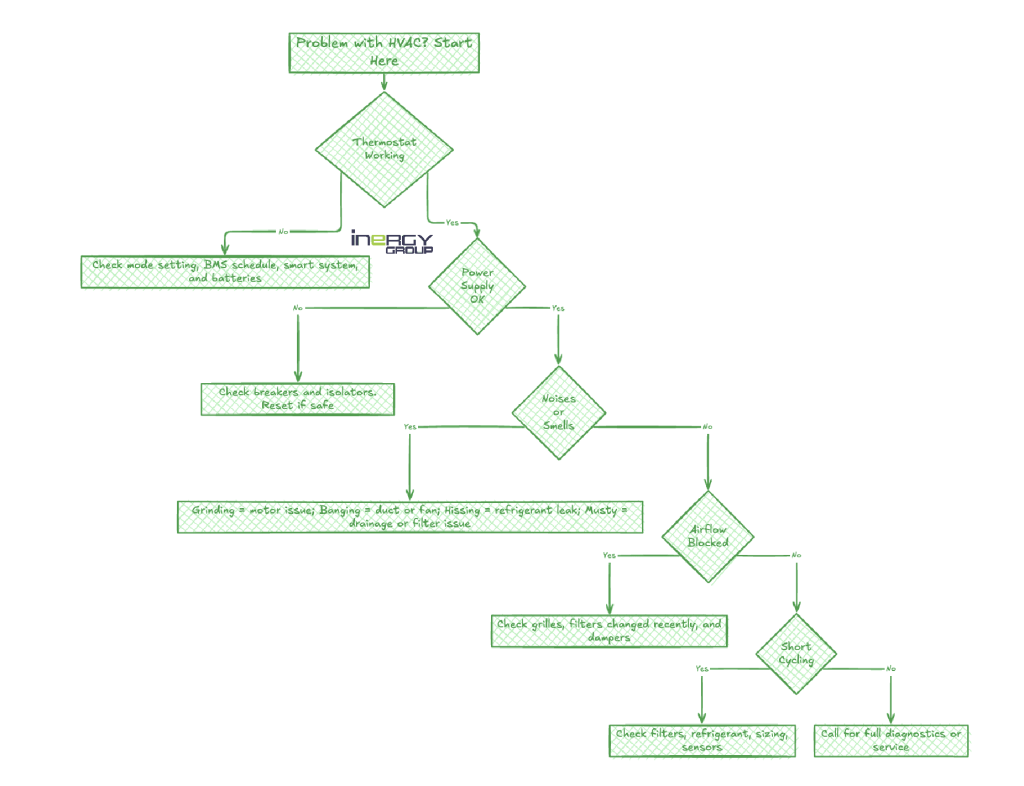
Compliance and Installation Requirements
UK Regulations and Standards
Commercial ventilation installations must comply with multiple regulations and standards. Building Regulations Part F sets minimum ventilation requirements for different building types. BS EN 13779 provides detailed guidance for non-residential building ventilation design. The Health and Safety at Work Act requires employers to provide adequate workplace ventilation.
Professional design by qualified engineers ensures compliance and optimal performance. Experienced HVAC specialists understand the complex interactions between ventilation, building physics, and regulatory requirements.
Installation requires skilled technicians with relevant qualifications and experience. Gas Safe registration is required for work involving gas heating systems. Electrical work must comply with BS 7671 wiring regulations. F-Gas certification is necessary for refrigeration work on air conditioning systems.
Professional Installation and Commissioning
Proper commissioning distinguishes successful projects from problematic installations. Commissioning involves testing all system components, verifying performance against design specifications, and training operating staff. This process ensures systems operate as intended whilst providing documentation for regulatory compliance.
Air flow measurements verify proper distribution throughout occupied spaces. Pressure testing confirms ductwork integrity and identifies leakage problems. Control system testing ensures automatic operation under all conditions including emergency scenarios.
Building Control approval is required for most commercial ventilation installations. Plans must demonstrate compliance with regulatory requirements before work begins. Completion certificates confirm installations meet approved designs and safety standards.
Are you planning a commercial ventilation project? Our experienced team provides comprehensive design, installation, and maintenance services across the UK. Contact our specialists today for expert guidance on your ventilation requirements.

Choosing the Right Commercial Ventilation Partner
What to Look for in a Ventilation Specialist
Selecting the right contractor significantly affects project success and long-term system performance. Look for companies with relevant experience, proper qualifications, and comprehensive service capabilities. The cheapest quote rarely provides the best value when ongoing performance and reliability are considered.
Experienced contractors understand the complexities of commercial ventilation design and installation. They can identify potential problems during the design phase and recommend solutions that prevent costly modifications later. They also provide realistic timescales and budgets based on actual project requirements.
Professional accreditations demonstrate commitment to quality and ongoing development. Look for CIBSE membership, Gas Safe registration, and relevant manufacturer certifications. Insurance coverage should include public liability, employer’s liability, and professional indemnity protection.
The Importance of Ongoing Support
Commercial ventilation systems require ongoing support to maintain optimal performance. Choose contractors who provide comprehensive maintenance services, emergency support, and system upgrades as requirements change.
Regular maintenance contracts ensure systems receive proper attention whilst providing budget certainty for ongoing costs. Emergency support minimises business disruption when problems occur. Upgrade services help adapt systems as businesses grow or change.
The best contractors build long-term relationships with clients, understanding their specific requirements and providing proactive support. They monitor system performance, recommend improvements, and help plan for future needs.
Get in touch with us today:
📞 Phone: 01204 929999
✉️ Email: info@inergygroup.co.uk
Why Choose Inergy?
With over 20 years of experience delivering commercial ventilation systems across the UK, Inergy Group has earned a reputation for combining technical precision with practical, long-term support.
We don’t just install systems – we work closely with clients to design, deliver, and maintain ventilation solutions that meet the demands of their buildings and business operations. Our clients rely on us for:
-
Over two decades of HVAC and industrial ventilation expertise
-
Accredited, professional commercial HVAC engineers
-
Health & safety-led installations across the UK
-
Transparent documentation and clear project communication
-
Tailored service and maintenance plans
-
Local and nationwide support
We build systems that last – and relationships that grow! When you work with Inergy, you get more than a contractor. You gain a trusted partner committed to long-term system performance, energy efficiency, and operational reliability.
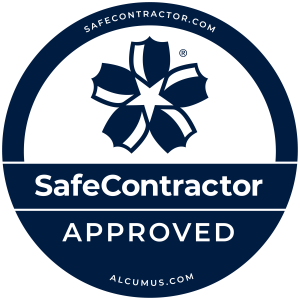
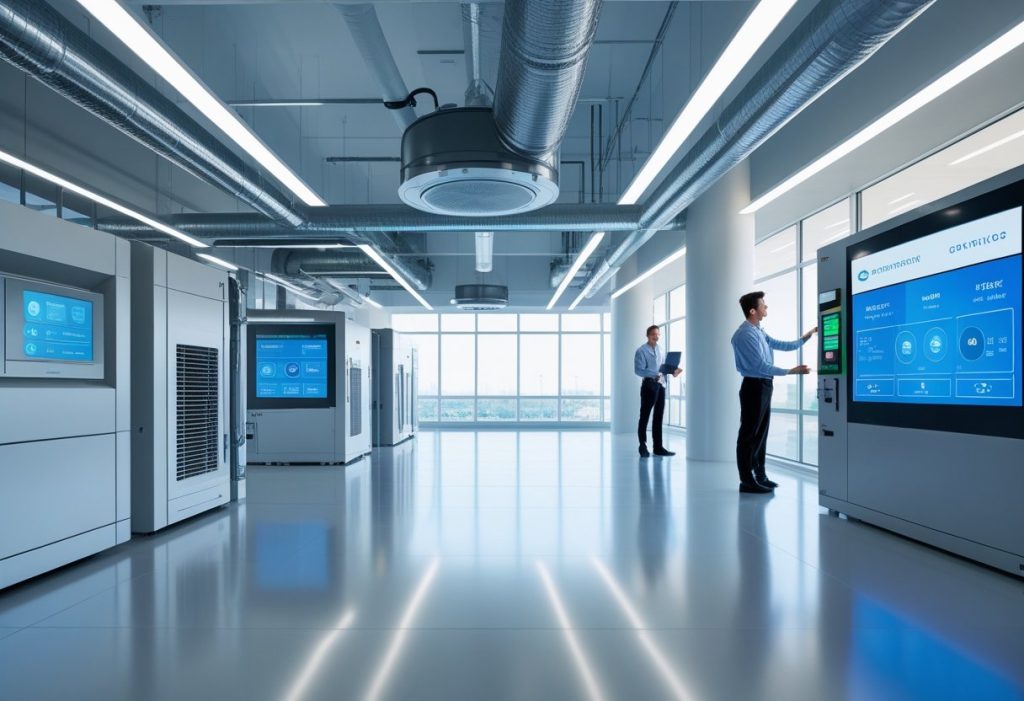
Future Trends in Commercial Ventilation?
Smart Controls and IoT Integration
Commercial ventilation systems are becoming increasingly intelligent through advanced sensors, cloud connectivity, and artificial intelligence. These technologies enable predictive maintenance, automated optimisation, and integration with broader smart building strategies.
IoT sensors can monitor multiple air quality parameters in real-time, providing data that enables precise control whilst identifying trends that predict maintenance needs. Cloud-based analytics can optimise system performance across multiple buildings whilst providing detailed energy consumption reporting.
Artificial intelligence algorithms learn from building usage patterns and automatically adjust ventilation strategies to optimise comfort, air quality, and energy consumption. These systems continuously improve performance through machine learning whilst reducing the burden on facility management staff.
Sustainability and Net Zero Goals
Growing environmental awareness drives demand for highly efficient ventilation systems with minimal carbon footprints. Heat recovery technology, efficient components, and smart controls all contribute to reduced energy consumption and environmental impact.
Renewable energy integration enables ventilation systems to operate with zero net carbon emissions. Solar panels can power fans and controls during daylight hours whilst battery storage provides evening operation. Heat pumps can provide heating and cooling whilst recovering waste heat from ventilation systems.
Life cycle assessment considers the environmental impact of manufacturing, installation, operation, and disposal. Sustainable design specifies components with low embodied carbon, high durability, and recyclability at end of life.
Ready to improve your building’s air quality and energy efficiency? Our expert team designs and installs cutting-edge commercial ventilation systems tailored to your specific requirements. Call us today on 01204 929999 to discuss your project and discover how we can help your business achieve its ventilation goals.
The investment in quality commercial ventilation delivers measurable benefits through improved employee health and productivity, regulatory compliance, energy savings, and enhanced building value. With proper design, installation, and maintenance, modern systems provide decades of reliable service whilst contributing significantly to business success and environmental responsibility.


